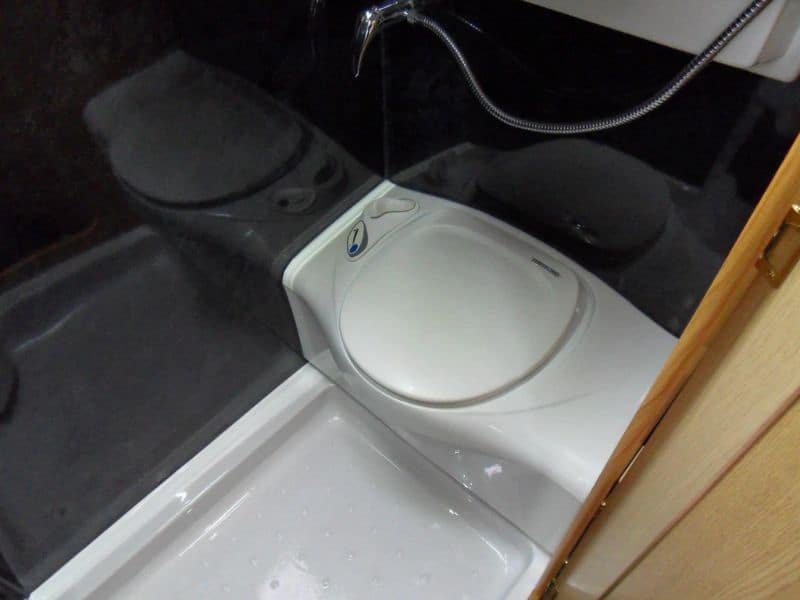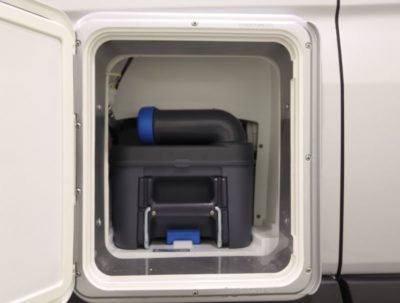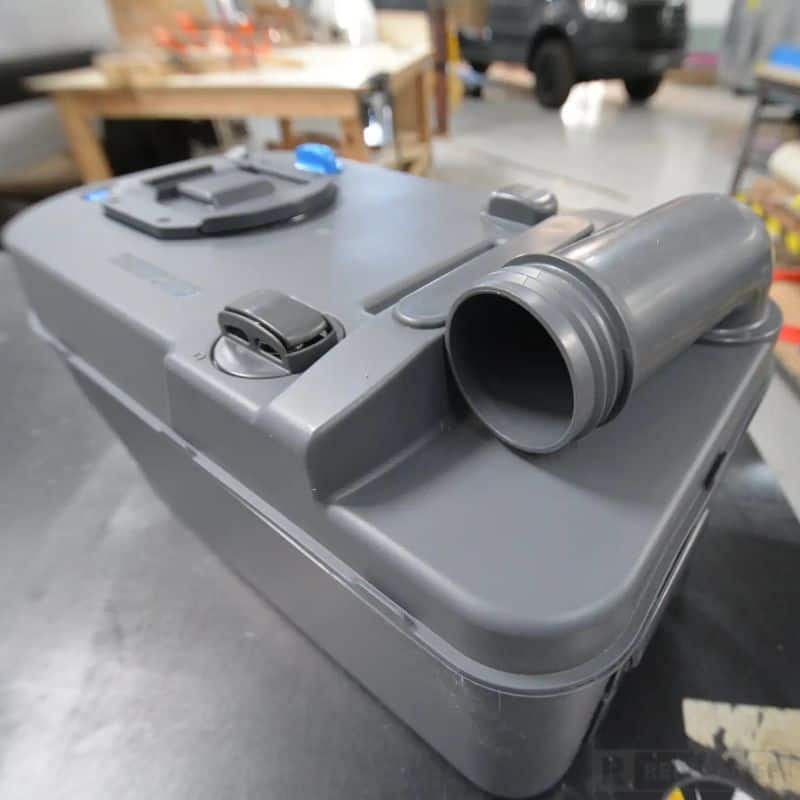Like most things in America, they were popular in Europe first. Cassette toilets have recently made inroads in the United States RV market, and they’ve piqued people’s interest. How does a cassette toilet work? Is it gross or smelly? And is this newfangled solution better than ye olde gravity toilet and black water tank?
Today, you’ll find cassette toilets in pop-ups, teardrops, truck campers, and mini travel trailers. You might be reticent about one. Is it a downgrade – or an upgrade?
Some campers luuuuuv cassette toilets. Some don’t. Think of them as an alternative, not necessarily an upgrade or downgrade. In this guide, I want to answer some common questions about RV cassette toilets. I think some of the answers might surprise you!
What Is a Cassette Toilet?
A cassette toilet is a permanent RV toilet with a removable tank for simpler waste disposal. You remove the tank, transport the tank to a dump station, and dump the waste.
(In recent years, some people have begun calling certain portable toilets “cassettes” as well if they have a removable tank. Those aren’t the subject of this post. Those work more-or-less like regular portable camping toilets, except better. Portable cassette toilets are usually only installed in conversion vans, pop-ups, and teardrops.)
Cassette toilets got their start in Europe. Then Americans started importing them for use in small Class B RVs and conversion vans. Today, cassette toilets are making serious inroads into the small RV market: You can find them in teardrop campers, small travel trailers, Class B’s, conversion vans, and truck campers.
There are two major manufacturers of cassette toilets used in North American RVs:
Cassette toilets are always installed against the outside wall of an RV. There is an access door on the sidewall where you can slide out the tank. Unlike a conventional RV, the holding tank doesn’t sit below the floor, inside the frame rails. It sits above the floor, directly below the toilet.

Again, don’t confuse a cassette toilet with a porta-potty! The two aren’t the same! A cassette toilet is a permanent toilet with a removable tank. It’s in a whole other league than a porta-potty or, even worse, a 5-gallon painter’s bucket full of sawdust.
Can You Poop in a Cassette Toilet?
Yup. Absolutely.
RV cassette toilets are designed to handle all forms of human waste, both liquid and solid. So proceed as usual!
Now, some campers choose not to go No. 2 in their cassette toilet because they don’t want the hassle of empty human effluent. We’ll deal with that concern in a minute.
Does an RV Cassette Toilet Smell?
No one wants to use a toilet that stinks, no matter how many other benefits it may confer! So let’s answer the most important question: Does a cassette toilet smell bad?
Properly maintained, no, a cassette toilet shouldn’t smell! Obviously, human waste sitting in a sealed container doesn’t smell good, but the system should isolate those smells. If odors are leaking into your living space, you may have a damaged rubber seal or flush ball valve.
But you should still strive to reduce tank smells as much as possible, both for A) when you dump and B) when you press the flush lever to open the ball valve. Thankfully, you can add a simple deodorizer pack. Each manufacturer has its own recommendations. Some toilets even have a built-in compartment for these chemical concoctions!
If you don’t want to use a commercial deodorizer, you can use a mixture of water and vinegar. Some conventional RV black tank deodorizers don’t work well in cassette toilet tanks because they are air-sealed; aerobic bacteria can’t survive.
Most RVers would say a cassette toilet smells no more (nor less) than a conventional RV toilet.
How Long Will a 5-Gallon Cassette Toilet Last?

How often do you need to empty a cassette toilet?
If you’ve been shopping around, you’ve probably been taken aback by the tiny capacity of most cassette toilets. “5 gallons? Really? How long will that last – four days?!”
Well, I did the math.
- On average, a person produces about 1500 milliliters of urine and 500 milliliters of poop a day (no, I didn’t measure. I Googled.)
- Do some back-of-the-envelope math, and that’s about half a gallon of waste every 24 hours per person. (Taco Bell may increase these values).
So if two people are using a cassette toilet full-time, you’ll get about five days of use. But if a family of four is using a cassette toilet over a weekend, it could fill up by Sunday evening!
That’s why most people opt to use a cassette toilet as a last resort. If you can, use the facilities at a convenience store or at the campground bathroom. You’ll get more time between dumps. That’s the number one rule of any RV toilet: Never pass up a public toilet when you get the chance!
Note: Unlike an RV composting toilet, a cassette toilet doesn’t separate solid and liquid waste. Everything goes into the pot!
How Many Flushes Does a Cassette Toilet Have?
This question may or may not pertain to your cassette toilet. In most RVs, a cassette toilet is plumbed directly to the freshwater supply system. So you never run out of water! A PEX tube or flexible vinyl hose delivers water straight to your toilet for endless flushes.
However, if you have a cassette toilet in a small van or renovated RV, then you may have a fillable reservoir instead. Here are some flush tank capacities of common Dometic and Thetford cassette systems:
- Dometic CTW 4110: 7 liters flush water tank capacity
- Dometic Saneo: 7 liters flush water tank capacity
- Thetford C402C: 15 liters (4 gallons) flush water tank capacity
- Theford C223-CW: 9 liters (2.4 gallons) flush water tank capacity
The volume of water per flush is variable. But as a rule, you can get 12-20 flushes per gallon, or 3-5 flushes per liter. Premium built-in cassette toilets have a push-button flush. Cheaper models have a manual hand lever.
(Speaking of flushes, there’s an old saying about water-saving toilets: “If it’s yellow let it mellow; if it’s brown flush it down.” If you’re desperate to save water, feel free to follow this advice.)
Just don’t starve your toilet of all moisture! Your tank needs water to dissolve the solids. You want to be dumping liquid, not sludge. Repeat: If you only use your cassette toilet for emergencies (especially No. 2 emergencies), then you may need to add more water than you think!
How Do I Know When My Waste Tank Is Full?

Unlike a conventional RV black tank, which usually has probes wired to your switch monitor panel, a cassette toilet usually has a built-in tank level sensor. Some units even have touch-screen displays! Others show blinking or colored LEDs to show when the tank is full (or nearing full). Keeping your tank clean helps keep your sensors accurate.
Where Can I Empty a Cassette Toilet?
A cassette toilet can be emptied into any approved RV dump station.
… Or even a regular toilet or pit toilet! You might get some weird looks hauling your blue tank through a Flying J, but hey, it’s legal!
Some people may choose to dump their cassette toilet tanks into their home’s septic system via the 3” or 4” sewer cleanout. As you can read in this article about installing RV hookups at home, this may/may not be allowed by your municipality. Do your research first!
How Do I Dump a Cassette Toilet Tank
Some people fear getting “up close and personal” with the sanitation system. That’s an understandable fear. But there’s good news! You really don’t handle the waste any more than usual. Here’s how it works:
- Remove the tank through the access door on the side of your RV.
- Roll, drive or tow the tank (like a suitcase) to an approved dump station or public toilet.
- Dump the tank, either through the spout or with a sewer hose!*
- Reinstall the empty tank underneath the toilet.
A quick note on Step #2: If you don’t want to manually roll your tank long distances, you can haul the tank in a vehicle! Or some models connect to the tow ball of a truck (adapter[s] may be required).
Also, most cassette toilets have an extendable spout with a cap. When it comes time to empty, you simply extend the spout, remove the cap, tilt the tank, and voila!
If you’re nervous about accidentally creating a mess, you can also attach an RV sewer hose to the spout, which usually requires an adapter, and proceed as normal. However, now you’ll need a container in which to store your Stinky Slinky.
How Do I Rinse and Clean a Cassette Toilet Tank?
Cleaning a conventional RV waste tank can be … quite an exercise! Most modern RVs have black tank spray rinse ports, but if not, you have to get creative. Owners often manually clean their holding tanks using a toilet spray wand or a pressure washer with a flexible rod through the sewer valve (just imagine an enema).
But a cassette toilet tank? Oh, it’s so easy! Just add water and soap (or your cleaning agent of choice), slosh around, and dump as usual!
Can You Use Normal Toilet Paper in a Cassette Toilet?
In my expose on RV toilet paper, I argued that RV-specific toilet paper isn’t really necessary for most systems. Most septic-safe toilet paper products will work, especially those that dissolve quickly in water without agitation (like recycled toilet paper or bamboo paper).
This holds true for cassette toilets – you don’t have to use RV toilet paper. However … the thinner, the better. No one wants to trust a toilet paper so thin it fails on the job, but choose a toilet paper as thin as your risk level allows.

Some people even choose to toss their toilet paper in a trash bin (with a covered lid, obviously) rather than flush it down. While we Americans may cringe at this idea, it’s common practice around much of the world. Plus, if you’re not flushing, then you can use your favorite triple-ply paper – or even wet wipes!
Is a Cassette Toilet Better?
I won’t argue that a cassette toilet is necessarily better than a conventional RV toilet and tank combination. But a cassette toilet does confer some interesting benefits.
For one, it’s almost 4-season ready! There’s no need for heat tape or tank insulation blankets. Because the tank is inside the conditioned airspace, it stays warm when you’re camping in the winter. And there’s no winterization required besides emptying the tank.
Secondly, you can dump almost anywhere: RV dump stations, vault toilets, residential toilets, rest stop bathrooms, porta-potties, etc. That’s unparalleled flexibility. And you don’t have to pack up and move your RV or camper to dump! Just tote the tank.
Pros of a Cassette Toilet
- Unobtrusive! Can be installed almost anywhere.
- No nasty Stinky Slinky!
- Don’t have to drive your RV to dump your waste tank[s].
- Extended stays. Once your cassette toilet tank fills up, just empty it into a portable tank.
- Easy to clean! No more toilet wand!
- Almost 4-season! Tank not exposed to the outdoors.
- Easy to replace; just buy a new tank.
Avoid the dump lines; dump where you want!
Cons of a Cassette Toilet
- Limited capacity: 5 gallons is standard.
- Limited availability, seat heights, and colors.
- Tank can be difficult for older or weaker people to handle.
- More waste handling required.
How Much Does a Cassette Toilet Cost?
A built-in cassette toilet from Dometic or Thetford, at the time of this writing, costs $600 – $800 retail. Remember that you’ll need both the commode and the access panel for the sidewall installation!
Still not convinced? Go try one! Find your local RV dealership and ask for a walk-through of a unit with a cassette toilet. Even better, ask for a demonstration (with clean water, obviously). You might be surprised. Cassette toilets come with a lot of benefits – you might just be glad you found one!
Leave a Reply